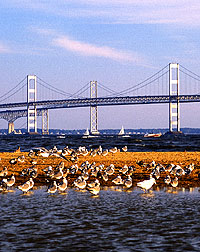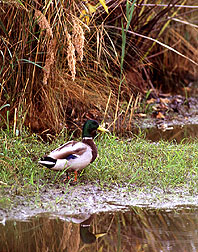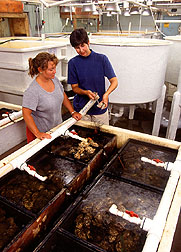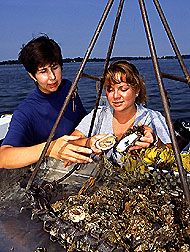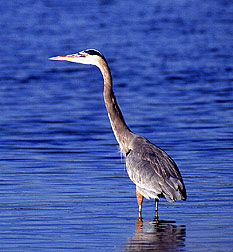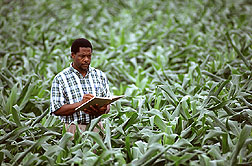Protecting the Chesapeake Bay
We tend to think of runoff water as the source of pollutants in rivers, lakes, and estuaries.
While that is largely true, runoff is not the only source of pollution. Pesticides, nitrogen, heavy metals, and toxic compounds are literally falling from the sky into the Chesapeake Bay and other bodies of water around the world.
Scientists with the Agricultural Research Service are documenting when, how, and how much nitrogen, pesticides, and other agricultural compounds reach the bay. If they find amounts to be excessive, their aim is to reduce the atmospheric entry of these agriculturally based compounds in the future.
The bay's watershed--all the land that drains into it--is 64,000 square miles, including all or part of six states, from New York to southern Virginia.
The U.S. Environmental Protection Agency (EPA) has a similar word--airshed--to describe the air source of a pollutant that falls onto the ground or water as gases or dry particles or is attached to water molecules in precipitation or fog.
An airshed is the air above a watershed--and then some. Unlike a watershed, an airshed has no physical boundaries. Its borders depend mainly on how far a specific airborne pollutant may travel. EPA has thus far mapped out an airshed only for nitrogen oxide emissions. The bay's airshed for these--mostly from autos and power plants--covers 350,000 square miles. It includes the air above all or parts of 13 states plus Ontario, Quebec, and all of lakes Ontario and Erie. The bay's nitrogen oxide airshed extends west to Michigan and south to South Carolina.
It is possible that the airshed for some chemicals reaching the bay may include the entire eastern United States. But the bay airshed is defined as the air from which 70 percent of a particular airborne chemical would drop on the bay or its watershed.
|
|
Ammonia by Air
As its next airshed map, EPA is considering ammonia gas. ARS scientists suspect the bay's airshed is smaller for ammonia than for nitrogen oxides because ammonia seems to travel much shorter distances.
"But we don't really know how far ammonia travels or how much of a problem it is," says ARS soil scientist John J. Meisinger. "It might go a half mile, or maybe 5 to 10 miles."
Meisinger studies ammonia gas escaping from poultry manure on Maryland's Eastern Shore, as well as from dairy manure at ARS' Beltsville (Maryland) Agricultural Research Center. He says poultry manure seems to give off less ammonia than previously thought.
He uses small wind tunnels and micrometeorology techniques to monitor ammonia losses from manure placed on fields. Meisinger is with the ARS Environmental Chemistry Laboratory in Beltsville. This lab, along with ARS' Pasture Systems and Watershed Management Research Laboratory in University Park, Pennsylvania, develops farm practices that protect the environment and food supply, with emphasis on the Chesapeake Bay watershed.
Phillip A. Moore, Jr., an ARS soil scientist in Fayettville, Arkansas, has found that ammonia loss is reduced if alum is mixed with poultry litter in the chicken houses. Poultry litter is a mix of bedding and manure.
Alum, or aluminum sulfate, is a mild acid that lowers the pH of litter, reducing ammonia volatilization in the chicken house and when the litter is applied to the field.
"If I had to pick a single solution for its potential to reduce both the problems of ammonia emissions to the air and phosphorus losses in runoff, I would place my money on alum for the short run," Meisinger says. Alum also changes the phosphorus in the litter to a form that is less soluble in water. [See "Managing Poultry Manure Nutrients," Agricultural Research, June 1998, p. 12; "A Cleanup for Poultry Litter," May 1994, p. 10.]
But Meisinger warns that alum is only a short-term solution. "Ultimately you have to find a way for chickens to use more of the nitrogen and phosphorus in the feed," he says.
Phosphorus by Land
Another soil scientist, Eton E. Codling, who is also at the Environmental Chemistry Laboratory, is investigating the effects of mixing alum residue from a drinking water treatment plant into chicken litter before applying it to cornfields at two farms on the Eastern Shore. The residue contains trace elements--particularly iron--removed from the drinking water by alum and lime.
Codling chose the farms after conducting a survey in 1997 of 10 Eastern Shore farms that have applied chicken litter to their fields for more than 25 years. He found that nine of the farms had high phosphorus levels and chose two of them for the alum residue study.
Phosphorus has gotten more attention recently because of its possible role in fueling toxic blooms of the microbe Pfiesteria piscicida in bay tributaries and other rivers on the East Coast.
Tom Simpson with the Maryland Department of Agriculture says he can find no agricultural trend to account for the Pfiesteria problem, other than rising phosphorus levels in soils. In the three counties that make up Maryland's lower Eastern Shore, phosphorus levels have risen steadily since about 1956.
A recent survey found levels in many soils to be three to six times higher than the maximum amount crops can use. Simpson stresses that no one has yet proven a Pfiesteria-phosphorus connection. Even so, algal blooms and oxygen depletion in the bay have a major economic impact on the region.
Maryland has long had a voluntary nutrient management program. But because of the Pfiesteria outbreak, the state is phasing in a mandatory program over the next 4 to 7 years. The program--the strictest in the country--targets phosphorus and nitrogen. Simpson says new poultry manure recommendations for a typical farm with high-phosphorus soils will be cut from 3 to 4 tons an acre to a half ton or less. Meisinger says these steep cuts should reduce losses of both phosphorus and nitrogen to the bay, but lower application rates will require more acres to spread the manure on and higher transportation costs to carry it farther away.
Says Simpson, "We have long depended on ARS research, in collaboration with the University of Maryland and other universities--particularly Meisinger's work with nitrogen and Andrew Sharpley's work with phosphorus. Sharpley is the world's number-one authority on phosphorus in runoff water. He did the pioneering work back in the 1980s. We depended on his work to help us recognize that runoff was carrying high levels of dissolved phosphorus."
Sharpley is a soil scientist at ARS' University Park lab, where a variety of studies important to the Chesapeake Bay are under way. Included is work on the effect of agriculture on nitrogen and phosphorus cycling, losses from intensively grazed pastures, and the role of wetlands and streambank vegetation in removing nitrogen from agricultural runoff.
Sharpley says that the only permanent solution to reducing soil phosphorus or nitrogen levels "is to balance farm input and output. In other words, producers should attempt to reduce the amount of phosphorus and nitrogen brought onto a farm as feed and fertilizer. They should supplement fertilizer use with on-farm manure where available," he says, "so that crops and animals are fed as closely as possible the phosphorus and nitrogen they actually need."
He says this is especially important in parts of a watershed particularly vulnerable to runoff. "Generally, most of the phosphorus running off watersheds comes from only a small area of the land during a few large storms."
Sharpley and others helped USDA's Natural Resources Conservation Service (NRCS) develop a simple index to pinpoint and rank the sources of phosphorus--the so-called hot spots.
|
|
Farmers whose soils have a low risk ranking would be advised to test the soil every 3 years and recommended to "keep up the good work and think before you make changes that could raise soil phosphorus levels."
Farmers with fields that have a medium risk should implement practices to reduce phosphorus losses, such as using less tillage, so as to cut runoff and soil erosion. Those fields with a high risk for phosphorus loss should receive phosphorous fertilizer or manure only sparingly. Farmers whose soils have a very high risk ranking would be advised to consider a more comprehensive test and to not apply phosphorous fertilizer or manure for at least 3 years.
Sharpley was recently appointed to coordinate ARS' contribution to a new national program with NRCS, universities, and EPA to assign phosphorus thresholds for a wide range of soil types across the United States by 2002.
Pesticides by Air and by Sea
Beltsville chemist Laura L. McConnell has spent several years sampling intensively for pesticides in water, air, and rain. Her biggest airshed experiment was a 3-year cooperative project at the mouth of the Patuxent River with the University of Maryland's Chesapeake Biological Laboratory at Solomons. She has consistently found pesticides in water, air, and rain, but only in concentrations well below EPA's health advisory levels for drinking water. For example, the agricultural herbicide atrazine shows up at levels of 0.4 parts per million (ppm) in some tributaries of the bay--amounts far less than the EPA drinking water guideline of 3 ppm.
McConnell has documented the continuing global air transport of old as well as new pesticides--including some that were banned years ago, such as DDT and toxaphene. She found these pesticides in the waters of the world's deepest lake, Siberia's Lake Baikal. Her work relies heavily on the findings of another ARS colleague, chemist Clifford P. Rice, who did the earliest studies of atmospheric transport of pesticides.
McConnell also collaborates with Steven J. Lehotay, Rice, and others in a study of oysters. This project is part of the National Oceanic and Atmospheric Administration's (NOAA) Mussel Watch program. It has been expanded to monitor oysters for newer pesticides. So far, no herbicides have been found. But the insecticide endosulfan has shown up consistently enough to prompt a closer look for it in waters of the Chesapeake Bay and other sites around the country by the Mussel Watch program.
One Fix: Reduce or Filter Runoff
Soil scientist Gregory W. McCarty, with the Environmental Chemistry lab, has finished his first year of a study to see how well a wetland can filter chemicals from farm runoff before the pollutants reach a bay tributary. The wooded, swampy wetland at the ARS Beltsville center receives runoff and groundwater from an adjoining field planted to corn this year. McCarty must often don wading boots and walk carefully across wetland muck to collect samples. In most places, a hidden mat of tree roots holds up the muck--and McCarty. He also samples water below the field, as well as below and in a nearby stream.
He found the test site has a complex natural plumbing system--including countless leaks that seem to weaken the wetland's filtering role. Some groundwater below the field flows directly into the stream through "holes" formed in the streambank by hydrostatic pressure.
The test results make McCarty doubt that this particular wetland protects the stream from nitrate--a form of nitrogen. He found that groundwater pouring into the stream is extremely clean, except for high levels of nitrates.
McCarty is also testing eastern gamagrass as a buffer strip at the edge of the field to filter out excess nutrients before they reach the swamp.
At experimental tomato fields in Beltsville, McCarty is checking runoff for nitrate and phosphorus. The tomatoes are grown by two contrasting methods. In the standard method, tomato seedlings are planted through sheets of black plastic mulch, a method widely used on Maryland's Eastern Shore. The alternative method uses hairy vetch residue as an organic mulch.
Chemist Cathleen J. Hapeman, who leads the Environmental Chemistry lab, and Pamela J. Rice, an ARS chemist and toxicologist, head up the tomato runoff project. Their data show that the plastic sheets allowed 10 times more runoff than vetch after the first storm of the 1997 tomato season--and twice as much in the following dozen storms. They are currently analyzing 2 years of data for pesticide and nutrient levels.
|
|
McCarty says the higher sediment amounts in runoff from the plastic-mulched areas point to a higher phosphorus load--since phosphorus tends to cling to sediment.
By themselves, none of these studies can answer questions about the actual toxicity of this runoff to bay organisms. To help find answers, Paul Hetzer is testing runoff from the Beltsville plots on bay creatures such as grass shrimp, clams, oysters, and sheepshead minnows at the Chesapeake Biological Laboratory. Hetzer is a graduate student at the University of Maryland at College Park.
Clifford Rice and Ed Johnson, formerly with ARS and now with NOAA, have monitored several artificial wetlands on the Eastern Shore for effectiveness in removing pesticides from runoff before they reach bay tributaries. They are working with NRCS and the Smithsonian Institution's Environmental Research Center.
So far, they have found the wetlands are doing an excellent job, especially during major rainstorms. For example, the amount of herbicides removed from runoff by two artificial wetlands in Kent County, Maryland, ranged from 83 percent for simazine to 95 percent for glyphosate.
Walter Mulbry, a microbiologist at the ARS Soil Microbial Systems Laboratory in Beltsville, is testing a very different type of artificial wetland--algae in tanks or long raceways--for effectiveness in removing nitrogen and phosphorus from dairy manure. These homegrown algae could be used as animal feed or as green manure for fields. Mulbry points out that since the algae are harvested often, they might have an insatiable appetite for nutrients--unlike the other kind of wetlands, which get filled up on the pollutants.
By land or by air, ARS scientists are determined to trace agriculture's possible role in Chesapeake Bay problems--and find solutions.--By Don Comis, Agricultural Research Service Information Staff.
Cathleen J. Hapeman and other scientists in the USDA-ARS Environmental Chemistry Laboratory can be reached at Bldg. 001, BARC-W, 10300 Baltimore Ave., Beltsville, MD 20705-2350; phone (301) 504-6511, fax (301) 504-5048 .
Andrew W. Sharpley is at the USDA-ARS Regional Pasture Systems and Watershed Management Research Laboratory, Curtin Rd., University Park, PA 16802; phone (814) 863-0948, fax (8140 865-2058.
"Protecting the Chesapeake Bay" was published in the January 1999 issue of Agricultural Research magazine.







